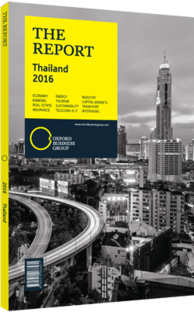Transport and logistics
The Company
Airports of Thailand (AOT) was formerly a government entity. The company changed its status to a public company in September 2002. Currently, Thailand’s Ministry of Finance holds a 70% investment stake in AOT. It operates six airports nationwide, including two in Bangkok (Suvarnabhumi International Airport, or SBIA, and Don Mueang International Airport, or DMK), two airports in the north (Chiang Mai International Airport, or CNX, and Mae Fah Luang-Chiang Rai International Airport, or CEI) and two airports in the south (Phuket International Airport, or HKT, and Hat Yai International Airport, or HDY). SBIA is the major airport hub, while DMK acts as the major hub for low-cost airlines (LCCs).
In financial year (FY) 2015 (ended September), 59% of AOT’s revenue came from aeronautical business, consisting of passenger service charges, landing and parking charges, and aircraft service charges. Meanwhile, 41% of total revenue was non-aeronautical, including concessions, office and state property rents, and other service revenue.
AOT’s passenger volume has grown in line with strong tourist arrivals to Thailand. With SBIA opening for commercial operation in 2006, AOT’s passenger volume grew by a compound annual growth rate (CAGR) of 8.5% between FY2007-15, while aircraft movements rose by 8% CAGR. Aggressive expansion of LCCs has not only increased the variety of tourist destinations, tourist numbers have also risen significantly. AOT’s decision to reopen DMK with incentive programmes to service point-to-point LCCs since October 2012 has also helped to boost tourist numbers. In FY2015, AOT’s passenger volume increased by 22% (to 107m passengers), while aircraft movements rose 16% (to 707,240 flights). This level of growth was partly owing to the low base as a result of Thailand’s political tension in the previous year.
Development Strategy
AOT aims to increase airport handling capacity to serve rising air traffic movements in the future, especially at SBIA, DMK, and HKT. In FY2015, these airports handled passenger volumes higher than their current capacities. The total investment for expansion of these three airports will be no more than BT119bn ($3.6bn), with the majority being for SBIA. The phase II expansion of HKT, which will increase passenger capacity to 12m from 6m, is in progress and is expected to start commercial operation by June 2016. The expansion includes a new passenger terminal, as well as renovations of the existing terminal, the apron and other facilities.
For DMK, the phase II expansion, which will bring passenger capacity from 11.5m to 30m, is also under way and expected to start operations in the first quarter of 2016. The works include renovations of many service areas, such as passenger terminal 2, the south corridor and pier no. 5, and the parking area.
For SBIA, some parts of the airport expansion valued at BT62bn ($1.9bn) have been approved by the government. Tendering is expected in the first quarter of 2016 with construction beginning in the second half of the year. The expansion will boost passenger capacity to 60m. AOT expects the work to be completed in 2019. AOT also plans to develop a third runway and terminal 2, with construction expected to be completed in 2019 and 2020, respectively.
AOT is also looking to increase non-aeronautical revenue by developing new business and marketing activities based on customers’ lifestyles and business development under the Airport City concept.
We forecast AOT’s net profit to achieve a 17% CAGR in FY2016-18E, owing to traffic expansion, lower incentive programme at DMK, and a greater commercial revenue contribution from the DMK and HKT expansions. Our passenger volume growth assumption is 11% in FY2016 and 7% a year for FY2017-18E, in line with volume growth. AOT’s strong cash on hand and low debt-to-equity ratio should support the company’s investment over the next five years.
You have reached the limit of premium articles you can view for free.
Choose from the options below to purchase print or digital editions of our Reports. You can also purchase a website subscription giving you unlimited access to all of our Reports online for 12 months.
If you have already purchased this Report or have a website subscription, please login to continue.

